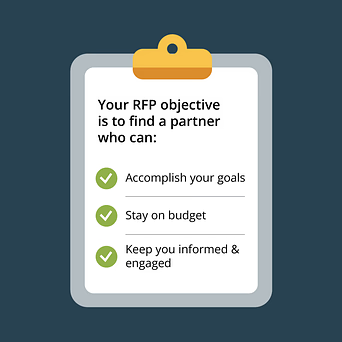
Sandra Fancher
January 17, 2025
About one-third of the RFPs I read do not include a budget. Those that do not list a budget often say, “We would like the responding vendor to present their best solution.”

Your real objective is to find the partner who can accomplish your goals with the budget you have while keeping you well informed and engaged. While I can respect not wanting to give a specific budget, allow me to present a few considerations.
In this situation, not giving a budget has a higher percentage of receiving similar bids for comparison. As long as your scope is clear for what you want, most agencies have standard pricing for websites and content writing type projects.
Industry research: Of all the RFPs over the last two years that Stamats has responded to, not responded to, won, or lost, the average website budget in a signed or sunshined agreement was $312,744. The highest at $953,763 and lowest at $172,000.
When budgeting, some additional costs include:
This is where I believe a budget would best serve you so that you can get a comparable answer. Digital marketing offers a wide range of advertising tactics, but each has very different costs.
Understanding the budget range helps RFP responders put together the best package of ad tactics they believe will achieve your stated goals.
Here is an example of seemingly similar ad tactics with very different costs:
Imagine you were buying a house and you asked your realtor to find you the best deal for a 3-bedroom, 2-bath, 2-car garage with at least 2,000 square feet in a specific zip code. Even though this sounds like a lot of details, there are significant differences.
For example,
You can see that the same specs can vary in price by over 400%. Providing a budget would have allowed the realtor to give you better options. It’s similar with digital marketing. You can provide scope, such as the amount of programs and enrollment goals, but if the budget is very limited you might not be able to afford the options.
Where a realtor has an opportunity to talk to you and understand your needs, an RFP response limits the personal side of crafting the best solution. Therefore, more context will create better plans for you to review.
Your main objective is to find an ideal partner. Since your budget most likely can’t change (although wouldn’t it be neat if the budget was adjusted each quarter based on results?), you need to focus the discussion on tactics and outcomes.
Without a budget in your RFP, a partner will suggest a wide variety of tactics that might not be relevant to your budget. That requires additional rounds of review. If you get dozens (even hundreds) of responses, you might not be negotiating with the top five best partners, but you won’t know that because they each provided different budget strategies.
This is a very viable situation. Schools approach us in early stages to ask for typical scopes and ranges. If that isn’t an option, consider asking on a listserv or network of friends for their range. You can also turn to public data. Using ChatGPT, type in “How do I find what a public school paid for their website?” Then refine from there.
Consider asking for a plan with three different budget scenarios. Scenarios in any case can be a good idea to see what strategies would change with more or less budget. It often isn’t just “spend more or less”—the actual tactics should change.
I was once asked in an RFP, “If we provide an extra 1 million dollars to the campaign, what would you do?” I won’t detail my answer because I think it was pretty awesome (you can call me and we can chat about it!), but it definitely was not, “Send more money in the current strategies.”
If you want a true apples-to-apples comparison in digital marketing, I believe it is in your best interest to provide a budget range.
One last suggestion specific to digital RFPs: Consider the overall price of ad spend and management. In the last 20 audits conducted, every single one was improperly allocating ad spend due to poor ad management. When you focus on how little you are spending on management, you most likely will end up overspending or poorly spending in ad spend. A well-run campaign with higher management fees should be able to produce the same amount of conversions with less ad spend and often with an overall lower cost. It takes management fees to make sure the entire process is optimized.
When Stamats recently took over digital campaigns for a private university in New England, we quickly realized that the current campaign set up was bleeding money spending most of their budget on branded search. Most of the budget was going towards people who already knew the university name and were including it in their search query.
By blocking branded search from Performance-Max campaigns and shifting to asset groups focused on specific programs while dedicating search campaigns to exact match branded searches, we were able to increase conversions by 244% while cost per conversion dropped by 58% with no increase to their budget within one month of launching the campaign updates.
We saw similar results when a community college in the Midwest hired us to manage their digital campaigns. We determined the best way to maximize their current limited budget was to align their ad spend and creative strategy with important dates in their admissions cycle, including program-specific application deadlines, open house events, and semester starts. This strategy led to a 135% increase in conversions and a 53% decrease in cost per lead with no increase in their budget within two months of us taking over the campaigns.
Contact me to discuss a digital campaign audit.